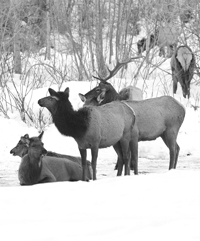It wasn't the outcome they were after, but the lawsuit they filed prompted it just the same.
After the Sagewillow Homeowners Association filed a lawsuit against The Community School on Nov. 14 calling for a plan to wean elk from being fed at the Sagewillow Barn in Elkhorn, the school responded by removing 4 tons of hay that was to be used for that purpose.
"We do not agree with the Sagewillow decision. But The Community School is in the position of education, not litigation," wrote Fritz Haemmerle, an attorney representing the Sun Valley school, in a letter to Sagewillow attorney Ed Lawson.
That decision got the homeowners' attention. They had been hoping to implement a cooperative, phased plan that would both put an end to feeding and encourage the elk to stay out of areas where they will likely eat ornamental vegetation.
"It's not what we were looking for," Lawson said. "We sent them a letter suggesting one of three alternatives, and they chose not to pursue any one of those. Instead they chose to terminate the feeding program, which my clients thought would be traumatic to the elk as well as cause damage to additional property unless it was done in a responsible way."
Haemmerle said The Community School's position is unflinching.
"The Community School board has considered the request," Haemmerle wrote Lawson in a Thursday, Dec. 13, letter. "Please be advised that the board has elected to stand by its prior decision not to feed the elk."
Haemmerle wrote that the school would prefer to spend its money on education than on litigation.
In an interview, he said, "The Community School board did not want to be involved in this type of litigation. The elk are not the agents of The Community School. They are wild animals, and wild animals do what wild animals do."
The practice of feeding elk at Sagewillow goes back decades and was begun by Ed Dumke, a longtime Sun Valley resident who gave the barn and barn property to the school some seven years ago. In doing so, he also bequeathed upon the school the longstanding tradition of feeding wild elk herds there in winter.
The issue of feeding elk is a murky situation because much of the suitable winter range in the Wood River Valley has been displaced by private homes. But the solution, according to the Idaho Department of Fish and Game, as well as to the Sagewillow Homeowners Association and their paid wildlife consultant, is not to feed, or to wean from feeding. Feeding attracts the animals to homes, where they eat landscaping.
"A lot of people don't understand that the elk, their basic instinct is to use those riparian bottoms in the wintertime, and that's exactly where we've built those houses in the Wood River Valley," said David Parrish, Idaho Department of Fish and Game's Magic Valley regional supervisor. "And a lot of the elk have been forced onto those hillsides. And it's more marginal habitat.
"Our position and our department policy is we do not feed deer or elk unless emergency conditions exist. When you feed elk, you attract them into a confined area. They can easily contract diseases among individuals. It's not good for their health. That's the bottom line."
The abrupt end to the feeding operation could encourage elk to drop in to the neighborhoods for a few seasons, said Regan Berkley, a biologist with the Idaho Department of Fish and Game's Magic Valley Region.
"You're right," she said. "They very well may and up in people's yards."
Just the same, Berkley said the department supports the end to feeding at Sagewillow and other locations.
"There is natural winter range up behind Sagewillow," she said. "There are several little gulches up there. And there are pieces of winter range on south-facing slopes all back behind there."
She said it would be "ideal" if the elk move into those areas of the Pioneer Mountain foothills where winter range still exists.
"I have no doubt that there will be potentially a couple of rough years when the elk will spend time feeding in people's yards, but I would hope the elk will find their way to those winter ranges back there," she said.
For Fish and Game, it can be an apparently hypocritical position. The department continues to feed wild elk herds in winter in the South Fork of the Boise River basin, and may continue feeding this winter in Warm Springs at a feed site it calls Bullwhacker.
"Absolutely, it's a tough situation," she said. "The difference for places like The Community School is there is winter range up behind there."
At Bullwhacker, she said, there is less natural winter range than in other locations where private entities have decided to undertake feeding operations.


 Elk congregate in valley lowlands near Ketchum. The Community School in Sun Valley has decided it will discontinue its elk-feeding program at the Elkhorn campus.
Photo by Mountain Express
Elk congregate in valley lowlands near Ketchum. The Community School in Sun Valley has decided it will discontinue its elk-feeding program at the Elkhorn campus.
Photo by Mountain Express



































